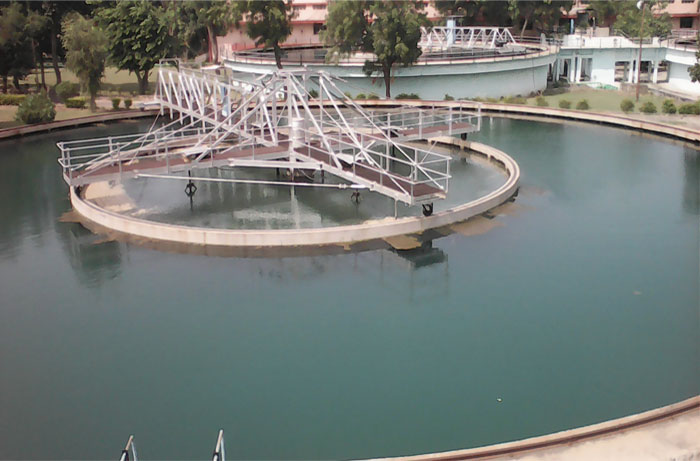Flocculator
Flocculator Plant in Pune | Mumbai

With progressively stringent directions and reception of film filtration, the weight is on for all phases of pretreatment — compound nourish, flocculation, sedimentation, and filtration — to act in show.
Accordingly, Aum Engineers has created Flocculation Systems™ — coordinating turbine, even, and water powered flocculators into multi-arrange frameworks with a self-cleaning pressure driven last stage, amplifying adaptability and execution.
Aum Engineers inventive multi-organize flocculation framework takes out the exchange offs regularly connected with G-esteem turbulence and conveys most extreme control and productivity each pretreatment arrange. Multi-organize flocculators use the greatest G-esteem go — from 2,000 to 0.
Whether it’s surface water or wastewater from domestic or industrial activities, all kinds of different pollutants have to be eliminated by Flocculator System in Mumbai to obtain truly water that is clean. Two of the first steps are liquid/solid separation, known as coagulation and flocculation. Whether for drinking or potable water, process water, raw water, industrial or municipal wastewater or sludge dewatering, it is important right across water use spectrum. The unit used worldwide to measure the clarity of the handled water is turbidity.
What are Coagulation and floculation?
The chemical process of contact and adhesion is known as Coagulation and floculation whereby the contaminants of a dispersion (colloids) form a larger-size cluster (flocs or flakes) allowing them to be more easily removed from water (e.g. by settling). The coagulation-flocculation procedures facilitate the removal of suspended and colloidal contaminants. It’s used in the first stage of solids-liquids separation: deciding, flotation or filtration by the help of Flocculator Plant manufacturer in Pune.
Coagulation and flocculation by Flocculator System in Pune are an important part of normal water treatment as well as wastewater treatment. This article provides an overview of the procedures and looks at the latest thinking. Material for this article was largely taken from reference.
Coagulation and flocculation by Flocculator Plant in Pune and Flocculator Plant manufacturer in Pune are required procedures in various disciplines. In potable water treatment, clarification water using coagulating agents has been practised from ancient times. The Egyptians as early as 2000 BC to clarify river water used almonds smeared around vessels. As a coagulant the use of alum by the Romans was mentioned in around 77 AD. Alum was being used by 1757, for coagulation in municipal water treatment in England.
In modern Flocculator Plant manufacturer in Pune and Flocculator Plant manufacturer in Mumbai, coagulation and flocculation are still important components of the overall suite of treatment procedures – understandably, because since 1989 the regulatory limit in the US for handled water turbidity has progressively reduced from 1.0 NTU in 1989 to 0.3 NTU today. To consistently producing handled water turbidities of less than 0.1 NTU the Flocculator Plant in Pune is committed and also to guard against pathogen contamination.
Coagulation in Flocculator Plant manufacturer in Mumbai is also important in several wastewater treatment operations. In overloaded wastewater treatment plants Phosphorus removal is a common example and is the practice of chemically enhancing primary treatment to reduce suspended solids and organic loads from primary clarifiers.
Coagulation, flocculation and sedimentation procedures by the help of Flocculator Plant manufacturer in Mumbai and Flocculator Plant in Mumbai in wastewater treatment and water treatment are significant. Through substance reaction between coagulant and colloids Coagulation destabilises contaminants, and flocculation transports the destabilised contaminants that cause collisions with flocs. Essentially, to collect any waste in water such as earth contaminants, dust, fish eggs, etc., into flocs a coagulant is added to water. At the bottom of the sedimentation container, these flocs settle as these are heavier than water, it removes of 90% of the suspended particle.
Coagulation and flocculation
Suspended contaminants cannot be removed completely by plain settling. Large, heavy contaminants negotiate out readily, but smaller and lighter contaminants negotiate very slowly or in some cases do not negotiate at all. Because of this, the sedimentation step is usually preceded by a substance process known as coagulation. Substances (coagulants) are added to water to bring the unsettling contaminants together into larger, heavier masses of solids called floc. Along with, Aluminium sulfate (alum) other chemicals such as ferric sulfate or sodium aluminate are used for water purification.
Coagulation by Flocculator System in Pune and Flocculator System in Mumbai is usually accomplished in two stages: rapid combining and slow combining. To disperse the coagulants Rapid combining serves throughout the water and to ensure a complete substance reaction. Sometimes by adding the harmful chemicals just before the pumps this is accomplished, allowing the pump impellers to do the combining. Usually, though, a Flocculator System in Pune provides about one minute of detention time. A longer period of gentle agitation is needed after the flash mix to promote particle collisions and enhance the growth of floc. This gentle agitation, or slow combining, is called flocculation; it is accomplished in an aquarium that provides at least a half hour of detention time. The wooden paddle-type mixers of the flocculation container slowly rotate on a horizontal motor-driven shaft. After flocculation water by Flocculator Plant in Mumbai and Flocculator System in Mumbai, it flows into the sedimentation tanks. Some Flocculator Plant in Pune and Flocculator Plant in Mumbai combine coagulation and sedimentation in a single prefabricated steel unit called a solids-contact tank.

